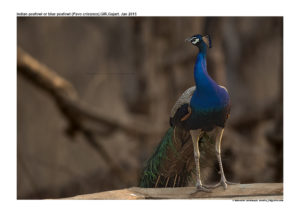
Indian Peafowl Pavo cristatus
Etymology:
- Pavo : Latin word for peacock
- Cristatus : Latin for crested
Vernacular Names: Sind: Mur, Hindi: Mor, Mayura, Pun: Mor, Ben: Mayur, Ass: Moira, Mora sorai, Mani: Wahong, Lepcha: Mongyung, Meghalaya: Dode, Bhutia: Mabja, Guj: (M) Mor, (F) Dhel, Mar: (M) Mor, (F) Landor, Ori: Mayur, (M) Manja, (F) Mania, Ta, Mal: Mayil, Te: Nemali, Kan: Navilu, Sinh: Monara
Distribution in India: Widespread Resident of India
Description: Size of male 180–230 cm, wt. of male 4000–6000 g, wingspan of male is 130–160 cm; size of female 90–100 cm, wt. of female is 2750–4000 g, wt. of female is wingspan 80–130 cm. It is very large, long-necked and small-headed pheasant. It has a velvet-blue head, neck and breast, with very distinctive crest, narrowly barred black-and-white patch on back, and long glossy green train. The female is distinctive, with white belly, brown upperparts, wings and tail, has elongated uppertail-coverts and glossy green neck. The juvenile is like female, but has less developed crest, paler head and inconspicuously barred upperparts.
Habitat: It is found in open forest with undergrowth along streams, secondary vegetation, orchards and other cultivation near villages, moist and dry deciduous forests near streams. It is found up to 2000 m. It roosts high in trees.
Food habits : It eats seeds, fruits,shoots,leaves, flowers, earthworms, insect, small reptiles, mammals and even small snakes. It forages in cultivated fields and fallow land. It forages in small groups.
Breeding habits: They breed in Jan- Apr in South India and Sri Lanka, Mar-Apr in Himalayan foothills. They are polygamous, with males possessing harems of more than two females, and gather at leks.The females prefer to mate with males that possess the most elaborate trains and, when mated randomly, produce more eggs for such males. The nest is a sparsely lined scrape, usually concealed in scrub. They lay a clutch of 3–6 eggs. The incubation period is 28–30 days and incubation done by female only.